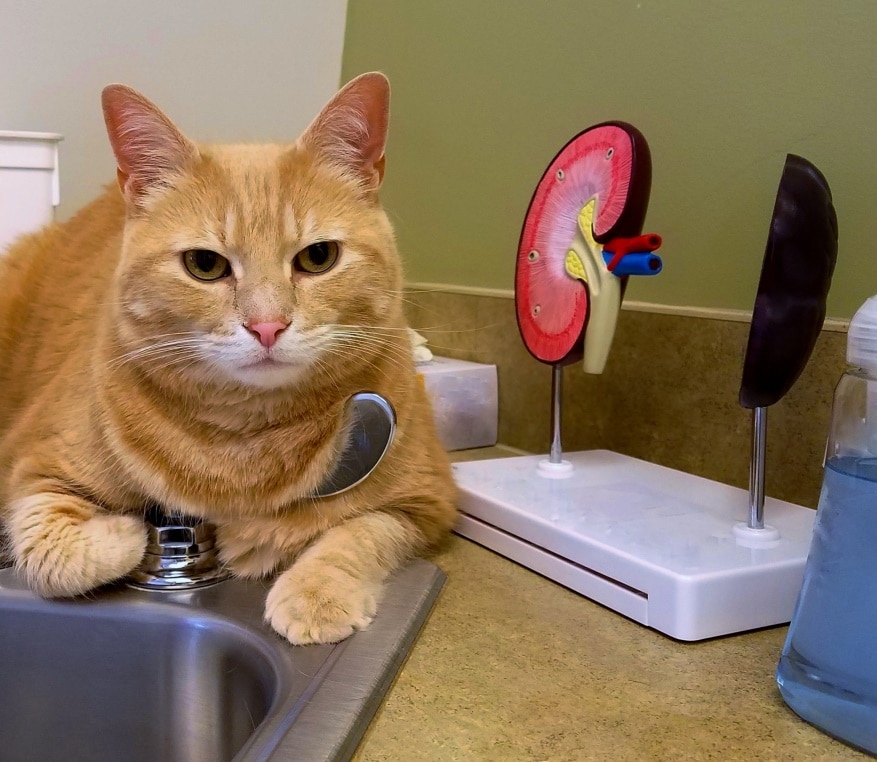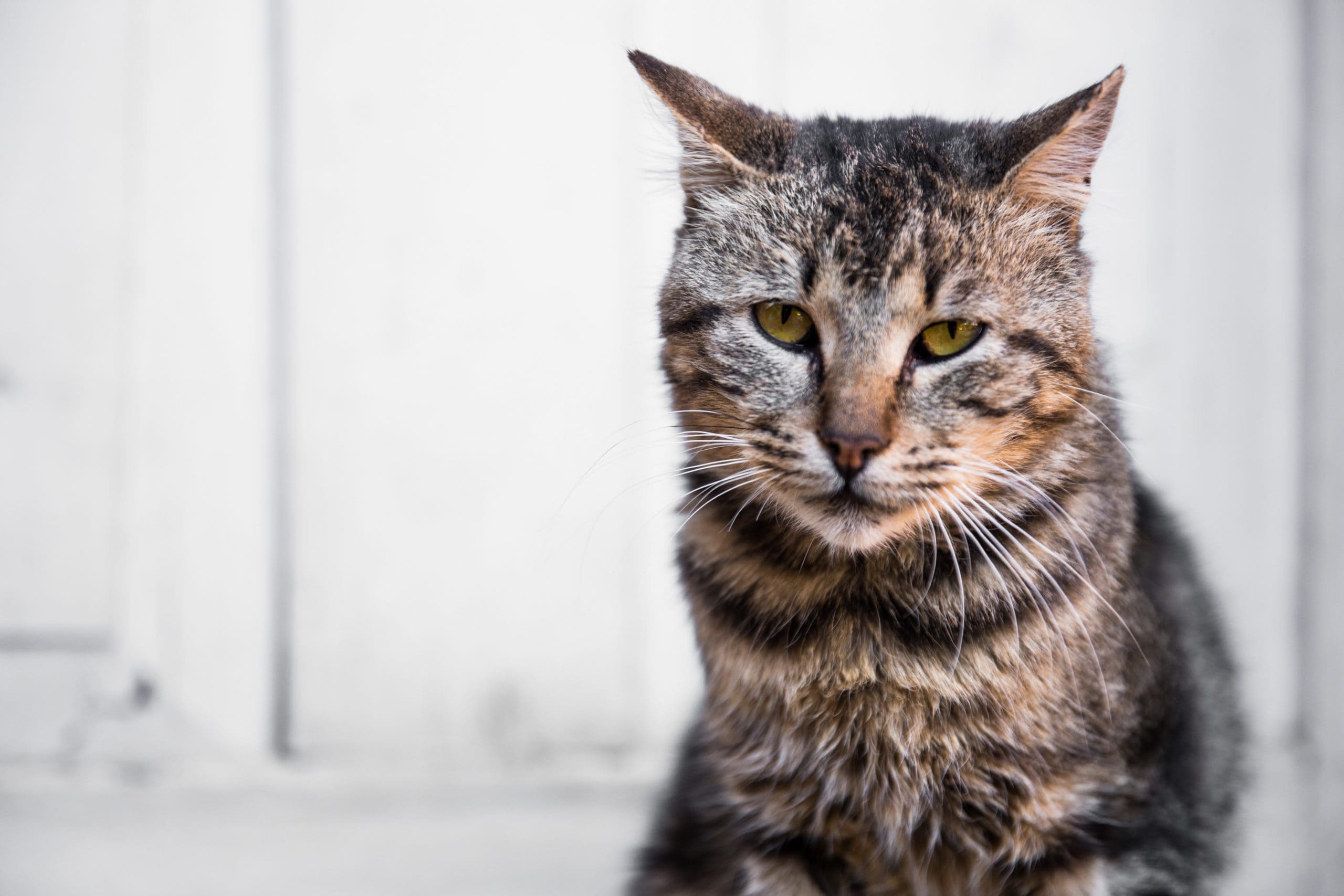Feeding considerations for cats with chronic kidney disease
Cats can be tricky to feed at the best of times, let alone when they are feeling unwell with chronic kidney disease (CKD). You may be familiar with E.A.T. (enhanced appetite trigger), a proprietary technology found in Hill’s Prescription Diet k/d and k/d + j/d. Hill’s team of experts matched the unique taste profiles of cats suffering chronic kidney disease with specific ingredients to create E.A.T. technology. E.A.T. terchnology is clinically proven to stimulate appetite in cats with chronic kidney disease and increase caloric intake1,2. Nevertheless feeding these cats can sometimes still present a challenge. Read on to find out how you can ensure optimal nutritional management of even the fussiest kidney cat.
Many cats with chronic kidney disease can be successfully transitioned on to a kidney diet at home
We usually recommend transitioning to a new diet over 7-days. When introducing a renal diet it is better to transition more slowly to the new food over a period of 3-4 weeks at minimum. This is because we really need to be successful at transitioning as the cat will need to be on a renal diet forever to optimise its quality and length of life.

I usually recommend that 25% of daily energy requirements should come from the new food in the first week and gradually work up to 100% from the new food by week 4. Many cats will transition much faster than this but occasionally a cat may require an even longer transition. Some cats do not like having the foods mixed together, so another option is to put them in separate bowls next to one another with the new food placed in the cat’s regular bowl. Ensure you establish realistic client expectations and follow up with them via phone. That way they are less likely to give up because the cat isn’t eating the food in the first week.
It is important not to introduce a kidney diet to a cat whilst they are in hospital. They are likely still feeling nauseous from a uraemic episode and may develop an aversion to eating the food. Likewise resist offering several foods at once, or you risk creating multiple food aversions. It is preferable to offer a wet mature adult food whilst they are in hospital. Hill’s Science Diet 7+ and 11+ diets are good options as they are controlled in phosphorus and sodium. It is imperative that nausea is controlled before offering any food. Once they feel better and are well enough to be discharged, start the gradual transition onto the new food at home.
Provided a cat is meeting their daily energy requirement, they will not be losing muscle due to a protein deficit
It is fairly common to see chronic kidney disease cats with significant muscle wasting. However, if the cat is meeting their daily energy requirements then they won’t be suffering from protein malnutrition as a result of eating the kidney diet. Both Hill’s k/d and k/d + j/d feline diets exceed the minimum recommendations for protein set by the National Research Council (USA).
So, if it’s not the protein levels in the kidney diet that is causing muscle wasting, what is?
Assuming chronic kidney disease patients are older, muscle loss could be occurring for two main reasons:
Sarcopenia: Age related muscle loss.
Cachexia: Muscle loss due to disease, a common consequence of CKD.
The earlier we can identify cachexia the better, as once muscle is lost, it’s gone forever. By providing at least 150% of every essential amino acid cats need vs. the American Association of Feed Control Officials (AAFCO), recommended minimum^, k/d helps inappetent cats with advanced CKD meet the amino acid requirements necessary to help prevent protein catabolism. To see how Hill’s Prescription Diet k/d supports a pet’s natural ability to build and maintain muscle mass watch this short 1 minute video.
There are several reasons a cat with chronic kidney disease may have anorexia
Ensure you investigate for an underlying cause of inappetance prior to dismissing the food as unpalatable. Whilst it may be tempting to switch to a non-kidney diet as many people feel ‘eating something is better than nothing’, this statement is misplaced.
Firstly, it’s important to remember that by far the most important thing we can do for the management of kidney disease is to feed these pets a kidney diet. The nutrition of Hill’s k/d, which includes controlled levels of high quality protein, phosphorus and sodium, and is clinically proven to improve and lengthen quality of life in cats with CKD.3,4 Feeding a non-kidney diet is going to exacerbate uraemia and lead to more rapid progression of the disease. Secondly, even if he is initially showing more interest in the non-kidney diet, they are unlikely to be eating sufficient quantities to maintain his body weight and muscle mass.
If a cat isn’t eating well there are better solutions than switching to non-kidney foods
Rule out metabolic causes of inappetence- There are a variety of metabolic causes of anorexia in cats with CKD including metabolic acidosis, dehydration, hypokalaemia, anaemia, uraemic gastritis and renal secondary hypoparathyroidism.5 In fact, up to 53% of cats with CKD will have metabolic acidosis, with the prevalence being higher in advanced stages of CKD.6
Offer another form of the kidney diet- It is not uncommon for cats with CKD to experience dysrexia and occasionally a cat may temporarily go off a particular food so it’s good to know that we can still provide a variety of nutritious options in these circumstances. For instance, Hill’s k/d is available as a dry kibble as well as several different forms and flavours of wet k/d including chicken or tuna pate, chicken or salmon pouches and a chicken and vegetable stew. These preferences usually don’t last long and, often enough, the cat will resume eating the original diet.
Consider using medications to control nausea and/or using appetite stimulants-This is a useful option in the short term. Be mindful that you may need to lower the dose if the drug is eliminated via the kidneys.
Place a feeding tube- This is a fantastic option for many cats and ensures the cat is receiving sufficient calories and water and has the added bonus of enabling the cat to be medicated via the tube. The best tubes for longer term feeding are oesophagostomy (O) and percutaneous gastrostomy (PEG) tubes. Many cats tolerate these procedures really well, even those cats with IRIS stage 3 and 4 disease.3 O tubes can easily be placed by general practitioners and the owner can be taught how to use them. Hill’s k/d pouches and stews can be put in a blender and are easy to administer in liquid form down a size 12-14 French tube. The cat is still able to eat with the tube in place, but having the tube in place enables easy supplementation of their food intake when necessary.
Resources
- To learn more, visit the Hill’s Veterinary Academy and complete a complimentary short course on the Nutritional Management of Chronic Kidney Disease in Cats
- For specific nutritional case advice please ring our Hill’s Veterinary Consultation Service on 1800 800 733 or email the Hill’s HelpLine.Here is a link to the Hill’s HelpLine jot form.

Dr Annabel Robertson BVSc (Hons) MANZCVSc MBA, Hill’s Professional Veterinary Affairs Manager.
Annabel graduated from the University of Melbourne with honours in 2008. Since then she has worked as a small animal veterinarian in private practice in Australia and the UK. She also completed an internship in small animal medicine during this time and sat her membership in small animal internal medicine in 2012, and finished her MBA in 2015. Annabel joined the Hill’s team in 2015 as a technical services vet in Melbourne and became the Professional Veterinary Affairs Manager in 2021.
Updated August 2022 by Dr Delisa Appleton BVSc (Hons) PhD, Hill’s Professional Consulting Veterinarian.
References:
1.Jewell et al, Taste Preference in Cats is Influenced by Physiological State. Abstract: FASEB J April 2015 29:755.1
2. Only dry foods contain E.A.T. Technology. Hill’s Data on File (needs year, might be 2015, but check with GPVA/S&T)
3. Ross SJ, Osborne CA, Kirk CA et al. Clinical evaluation of dietary modification for treatment of spontaneous chronic kidney disease in cats. J Am Vet Med Assoc 2006;229:949-957.
4. Fritsch DA, Jewell DE. Acceptance and effects of a therapeutic renal food in pet cats with chronic kidney disease. Vet Rec Open, 2015; 2: e000128
5. Ross SJ. Feline chronic kidney disease: fact vs fiction, Hill’s Global Symposium Proceedings 2015: 13-22. Retrieved January 14 2020.
6. Elliott J, Syme HM, Reubens E et al. Assessment of acid-base status of cats with naturally occurring chronic renal failure. J Small Anim Pract. 2003;44:65-70.
^ According to AAFCO (Association of Animal Feed Control Officials) nutrient profiles for adult maintenance
Information in this material must be interpreted in line with and used on your own professional judgement and clinical experience.
HIMA-AR-2220DCFA.
